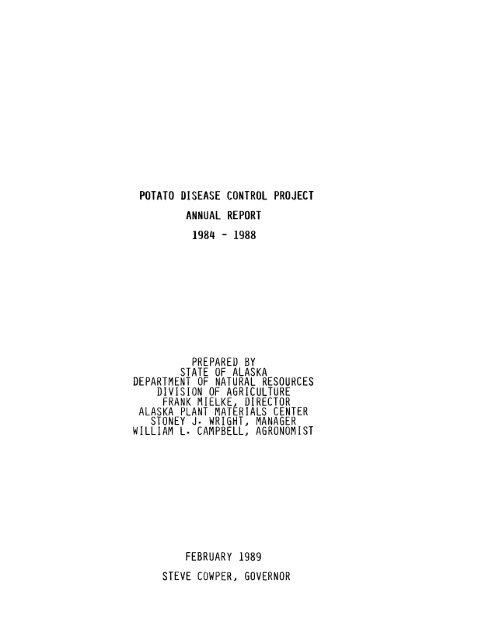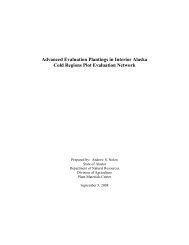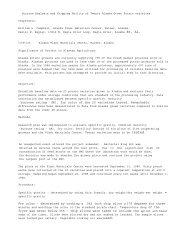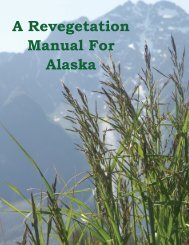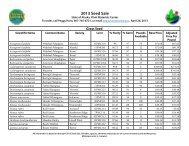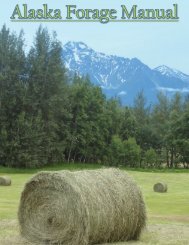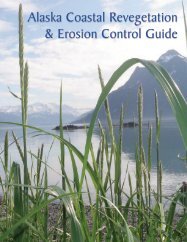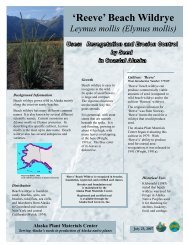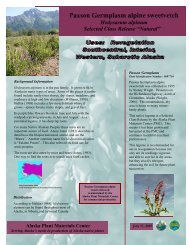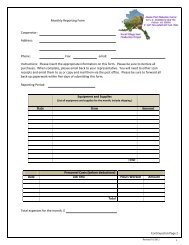Potato Disease Control Project - Alaska Plant Materials Center ...
Potato Disease Control Project - Alaska Plant Materials Center ...
Potato Disease Control Project - Alaska Plant Materials Center ...
Create successful ePaper yourself
Turn your PDF publications into a flip-book with our unique Google optimized e-Paper software.
POTATO DISEASE CONTROL PROJECT<br />
ANNUAL REPORT<br />
1984 - 1988<br />
PREPARED BY<br />
STATE OF ALASKA<br />
DEPARTMENT OF NATURAL RESOURCES<br />
DIVISION OF AGRICULTURE<br />
FRANK MIELKE} DIRECTOR<br />
ALASKA PLANT MATERIALS CENTER<br />
STONEY J. WRIGHT} MANAGER<br />
WILLIAM L. CAMPBELL} AGRONOMIST<br />
FEBRUARY 1989<br />
GOVERNOR<br />
STEVE COWPER~
<strong>Potato</strong>es are grown throughout the world in areas with a temperate climate.<br />
<strong>Potato</strong> farming is a major component of <strong>Alaska</strong>'s vegetable industry, with<br />
cash receipts approaching $2,000,000 annually. The potato has proven to be<br />
a well-adapted crop for <strong>Alaska</strong> over the last 50 years.<br />
<strong>Potato</strong> diseases cause significant economic losses in all areas where<br />
potatoes are grown. Large sums of money are spent each year on fungicides<br />
and insecticides and other pest control measures. The most commonly<br />
referred to disease control measure is to start with seed potatoes believed<br />
to be free of disease.<br />
<strong>Alaska</strong>n growers were experiencing severe losses caused by diseases in the<br />
late 1970s. The practice of using undersize tubers from the previous years<br />
commercial crop for seed was contributing to this problem. At the request<br />
of the growers, a project was established at the <strong>Alaska</strong> <strong>Plant</strong> <strong>Materials</strong><br />
<strong>Center</strong> to develop a source of disease-tested seed stock for distribution to<br />
seed potato growers.<br />
<strong>Potato</strong>es are usually propagated by planting pieces of tubers, and because<br />
many diseases are borne in or on potatoes, this method of propagation is<br />
considered the principal source of disease transmission. <strong>Potato</strong> seed certification<br />
programs have been developed to help identify disease problems in<br />
seed lots. <strong>Potato</strong> fields designated for use as seed are monitored by an<br />
inspector who walks through the fields looking for disease symptoms at least<br />
twice during the growing season. Fields in which the number of diseased<br />
plants found is less than the maximum allowed tolerance, are eligible to be<br />
labeled certified.<br />
These programs, however, work only to the extent that disease symptoms can<br />
be observed. Recent advances in disease detection and diagnosis coupled<br />
with tissue culture.production methods, have allowed for the development of<br />
laboratory potato propagation systems. Starting with material in which no<br />
diseases have been detected, thousands of plants can be produced in the<br />
laboratory isolated from disease-causing organisms. Seed tubers derived<br />
from these plants can then be replanted and grown under the guidelines of<br />
the certification program to help assure minimal disease problems. Seed<br />
improvement programs which limit the number of times the progeny tubers can<br />
be replanted have greatly improved seed quality in the last decade.<br />
The tissue culture phase of the potato seed production system requires the<br />
maintenance of sterile conditions. A piece of a plant, preferably an axillary<br />
bud, is surface sterilized in 10% chlorox water to eliminate surface<br />
contaminants. The tissue piece is then rinsed in sterile distilled water<br />
and placed in a test tube containing growth media. Usually within two<br />
weeks, the bud has rooted and begins to grow. When the plant reaches the<br />
top of the tube, it is removed. The top node is cut off and placed in<br />
another tube to continue growing. The middle portion is taken and tested<br />
for six viral diseases using ELISA tests. The bottom portion, approximately<br />
1/2 inch, is crushed and placed in a flask containing Richardson's media.<br />
This flask is placed on a rotary shaker and observed over a period of twenty<br />
days. Bacterial contaminants, if present, grow and cause the contents of<br />
the flask to become cloudy. <strong>Plant</strong>s which are negative in these tests, are<br />
used for producing the seed potatoes.
<strong>Disease</strong> testing of the potato plants grown at the PMC, is an integral part<br />
of quality control. Each year, all clonal material is tested for six virus<br />
diseases as well as bacterial and fungal contaminants prior to the<br />
expansion used for planting in the greenhouse. Field-grown material is<br />
observed each week during the growing season for evidence of disease, while<br />
a minimum of 25% of the plant population of each variety is tested for six<br />
viruses. Each pot in the greenhouses is also tested for the same six<br />
viruses just prior to harvest. Seed grower lots are tested for <strong>Potato</strong><br />
Virus X (PVX) and <strong>Potato</strong> Virus S (PVS).<br />
<strong>Alaska</strong> Seed Growers, Inc. is responsible for the certification of all seed<br />
potatoes in <strong>Alaska</strong>. The inspection of potato fields being grown for use as<br />
certified seed has been performed by <strong>Alaska</strong> Division of Agriculture<br />
personnel. The potato plant and its tubers are susceptible to many<br />
diseases. Seed quality is primarily determined by the relative freedom<br />
from these diseases. Field inspectors assist growers by identifying<br />
diseased plants and appropriate control measures. A minimum of two field<br />
inspections are made on each lot.<br />
Farmers everywhere strive to find varieties with special advantages.<br />
<strong>Potato</strong> breeding programs introduce new lines bred for specific purposes.<br />
Yield, skin color, disease resistance and processing qualities are a few of<br />
the characteristics by which various selections are made. <strong>Alaska</strong>n growers<br />
realize the possibilities a new variety could provide. They also realize<br />
that presently they have only minor disease problems in relation to other<br />
potato growing areas and by indiscriminately importing potato seed, they<br />
could introduce diseases that are not now known to occur in <strong>Alaska</strong>.<br />
The potato project has assisted growers by obtaining potato varieties from<br />
reputable labs and growers. These acquisitions are tested for diseases<br />
prior to being released to growers. This cooperative effort lessens the<br />
risk of introducing diseases into <strong>Alaska</strong>.<br />
Many potato varieties of interest to <strong>Alaska</strong>n gardeners are not available as<br />
disease-tested clones. Methods have been employed to free plants from<br />
disease. Four varieties in demand by <strong>Alaska</strong>n growers were cleansed of<br />
disease and made available as plants in 1988. The varieties <strong>Alaska</strong><br />
Frostless, <strong>Alaska</strong> Red, Peanut, and Rote Erstling have been added to the<br />
clone bank. Seven varieties are still in therapy.<br />
2
1984 1985 1986 1987 1988<br />
Number of tissue culture plants produced<br />
Number of tissue culture varieties<br />
Pounds of greenhouse tubes<br />
Total number of varieties<br />
Number of commercial seed lots inspected<br />
Seed lot acreage<br />
Number of virus tests - PMC<br />
Number of virus tests - commercial growers<br />
10,000 11 ,000 12,800 14,000 16,820<br />
9 20 27 34 52<br />
1,370 4,014 3,230 1,924 1,600<br />
12 34 75 97 104<br />
30 40 79 106 104<br />
29 44 34 42 30<br />
4,500 8,000 14,000 18,000 18,000<br />
1,000 1,500 1,000 3,500 1,500<br />
- 3 -
<strong>Project</strong>s secondary to the main goals of the disease project have been<br />
undertaken as time and money allow. The <strong>Potato</strong> project has been able to<br />
reprioritize efforts to help explore solutions to problems that require<br />
immediate attention. The donation of uncompensated overtime by employees<br />
has allowed many of these projects to be completed.<br />
1985<br />
Nitrogen Rate Observation Plot<br />
Nitrogen containing fertilizer added to soil used to raise potatoes has<br />
long been known to increase yield. High nitrogen fertilizer rates are also<br />
known to delay tuber set as well as the maturation of the crop. <strong>Alaska</strong><br />
grown potatoes do not have well developed skins at harvest time.<br />
Mechanized harvesting damages the skins of the crop, reducing the grade and<br />
allowing an entry post for pathogens. A plot was designed to allow for the<br />
observation of the effects eight rates of Ammonium Nitrate had on yield,<br />
specific gravity, and petiole concentration.<br />
1986<br />
Variety Demonstration Plot<br />
<strong>Alaska</strong>'s potato growers are constantly looking for a better variety of<br />
potato. An economic advantage exists if a russet or red-skinned variety<br />
can be found that will produce sufficient yield. At the request of<br />
growers, potato varieties are obtained, however, the introduction of new<br />
material to the <strong>Plant</strong> <strong>Materials</strong> <strong>Center</strong>'s variety collection poses some risk<br />
of accidentally introducing disease. All newly acquired material is<br />
isolated until sufficient testing can reasonably assure no diseases are<br />
present.<br />
Six to eight tubers of 41 varieties requested by growers for trials, were<br />
obtained from the Agriculture Canada Virus Free Program in Vancouver,<br />
Canada. The tubers were planted May 22, 1986, at a site near Palmer. This<br />
quarantine allowed observation and testing of the cultivars prior to<br />
commingling with the existing disease-tested clone bank.<br />
An area approximately 0.1 acre was cleared of existing brome grass turf<br />
using a front end loader. The area was fertilized at a rate equivalent to<br />
1,000 pounds of 10-20-20, sprayed with Eptam at a rate equivalent to one<br />
quart per acre, and then rototilled in. Seed tubers were cut into four<br />
seed pieces and the tuber units planted. Observations were made weekly.<br />
Tests for six virus diseases were made in late August. Local growers were<br />
invited to observe the harvest on September 17. Production was used to<br />
initiate clonal material and for further testing.<br />
- a
1986 Seed Size and Spacing<br />
Seed size and uniformity of placement at planting can have significant<br />
effect on overall yield. Several growers requested assistance in<br />
determining their performance in relation to theoretical standards.<br />
Samples consisting of a five-gallon bucket of cut seed were obtained. The<br />
seed pieces were weighed and counted into five groupings; i.e., less than 1<br />
oz., 1 to 1.5 oz., 1.5 to 2 oz., 2 oz. to 2.5 oz., and greater than 2.5<br />
oz. The percentage in each category was computed. The optimum seed piece<br />
size is purported to be 1.5 oz. Seed pieces less than 1 oz. and greater<br />
than 2.5 oz. are undesirable.<br />
The uniform placement of seed pieces in the row, maximizes production<br />
capability. <strong>Plant</strong> stands and consistency of spacing were monitored on five<br />
farms. The number of plants in six 25-foot lengths of row, were counted<br />
and compared to the desired population. An estimation of percent stand was<br />
calculated.<br />
1986 Cooperative National <strong>Plant</strong> Pest Survey Program<br />
The <strong>Alaska</strong> <strong>Plant</strong> <strong>Materials</strong> <strong>Center</strong> <strong>Potato</strong> <strong>Disease</strong> <strong>Control</strong> <strong>Project</strong> joined the<br />
National <strong>Plant</strong> Pest Survey Program in 1984. The program is designed to<br />
conduct surveys and improve methods for the detection and evaluation of<br />
important plant pests and enter data into a computer based national plant<br />
pest survey and detection program.<br />
The program assists in upgrading the quality of plant pest information and<br />
enables participation in a national plant pest data collection, storage and<br />
retrieval system. Participation in this program will facilitate research,<br />
extension and regulatory agencies in making decisions concerning plant pest<br />
protection.<br />
The potato project submits information on pests and diseases found in<br />
<strong>Alaska</strong>n potato fields during the growing season. This program has been<br />
continued through 1988.<br />
1987 Copper <strong>Center</strong> Native Corporation Trial<br />
The Copper <strong>Center</strong> Native Corporation agriculture project wanted to explore<br />
the potential of producing virus-free seed potatoes in the Copper <strong>Center</strong><br />
area. Seed potatoes from the <strong>Plant</strong> <strong>Materials</strong> <strong>Center</strong> disease-tested stock<br />
were made available for this purpose. Twenty seed pieces of ten varieties<br />
were planted at the Copper <strong>Center</strong> Native Corporation garden in late May.<br />
Leaf samples were collected by PMC staff in late August and tested for the<br />
presence of six viruses using the ELISA method. No virus diseases were<br />
detected. Yield and quality of the harvest was deemed acceptable by the<br />
agriculture project manager.<br />
5 -
- 6 -<br />
1987 Herbicide Evaluation <strong>Project</strong><br />
On October 7, 1986, the EPA announced an emergency order suspending the<br />
registration and prohibiting the distribution, sale and use of all products<br />
containing Dinoseb. This action caused the loss of the main weed control<br />
chemical used by <strong>Alaska</strong>n potato growers. Problems with herbicide<br />
carry-over had been noted with the alternative weed control chemicals<br />
Metribuzin and Linuron.<br />
At the request of growers, a plot was established at Pyrah's Pioneer Peak<br />
Farm to observe and quantify the effect of Metribuzen and Linuron on<br />
potatoes and subsequent crops. Three rates of Linuron and three rates of<br />
Metribuzin were applied across eight rows planted to different potato<br />
varieties. The Metribuzin was applied pre-plant with one split application<br />
treatment being applied post-emergence. Soil samples were taken prior to<br />
herbicide application and just before harvest. Weed growth and identity<br />
was noted as was any herbicide damage to the crop. The plot was harvested<br />
in September. Total yield was recorded.<br />
This plot was planted with seed of mixed vegetables, oats, and bluegrass,<br />
as well as transplants of broccoli, cabbage, and lettuce in 1988 to observe<br />
the effect of herbicide carry-over. Problems with the seeder and weed<br />
growth prevented obtaining verifiable information. Lettuce, broccoli,<br />
cabbage, and zucchini seeded rows did poorly on the Metribuzin treated<br />
areas of the plot.<br />
1987 Fairground Plot<br />
The <strong>Alaska</strong> State Fairground was selected as a site where cultivars from the<br />
<strong>Plant</strong> <strong>Materials</strong> <strong>Center</strong> could be exhibited to a large audience.<br />
The potato project planted 20 feet of row of 22 potato varieties in a plot<br />
just inside the west entrance. During the fair, personnel were on-hand to<br />
answer questions and explain the various qualities of the plant materials<br />
being exhibited. This project has been continued through 1988.<br />
1987 Harvester Adjustment<br />
Mechanical harvesting of potatoes exposes the crop to damage that can cause<br />
economic loss. <strong>Potato</strong> growers in Washington and Idaho recognized that<br />
modifications to harvesters could be made that would reduce the amount of<br />
damage incurred during harvest. The research they initiated, found several<br />
solutions to the harvest injury problem.<br />
Simple adjustments of the primary and secondary chain speed, as well as<br />
ground speed, can reduce harvest damage. Structural changes such as<br />
reducing the distance potatoes drop, or replacing link chain with belted<br />
chain, require a greater investment.
<strong>Alaska</strong>n potatoes do not have a well-developed skin at harvest. This<br />
condition predisposes the crop to mechanical damage. Reducing the amount<br />
of damage at harvest increases the value of the crop.<br />
Dr. Gary Beaver, Extension <strong>Potato</strong> Specialist in Idaho, was president of the<br />
<strong>Potato</strong> Association of America Anti-bruise Committee. The <strong>Potato</strong> <strong>Project</strong>,<br />
with financial assistance from growers, was able to bring Dr. Beaver to<br />
<strong>Alaska</strong>. Dr. Beaver was able to provide technical expertise about harvester<br />
adjustments that reduced bruise damage in <strong>Alaska</strong>.<br />
1988 <strong>Potato</strong> Scab Plot<br />
<strong>Potato</strong> scab is a disease caused by an organism named Streptomyces scabies.<br />
The organism causes problems that affect grade quality, thereby lessening<br />
the value of the crop. <strong>Potato</strong> scab is probably responsible for most of the<br />
disease-caused economic losses incurred by <strong>Alaska</strong>n potato growers.<br />
<strong>Potato</strong> scab resistance is usually incorporated into the genetic make-up of<br />
newly released potato varieties. In order to gain more understanding of<br />
the disease in <strong>Alaska</strong>, potato varieties deemed scab-resistant or<br />
scab-susceptible in other states, were planted in areas of fields known to<br />
be infested with with scab. Fields at two sites were planted with four<br />
seed pieces of 14 different varieties. Observations of the progeny tubers<br />
in September, revealed no scab on any of the potatoes. The reason no scab<br />
was found on the susceptible cultivars is unknown.<br />
1988 Shepody Spacing Trial<br />
The variety 'Shepody' has been shown to yield well in <strong>Alaska</strong>. One problem<br />
noted is the propensity for the potatoes to get too large. The distance<br />
between seed pieces has a direct effect on tuber size. To determine the<br />
effect of in-row spacing, a plot was established on the Mulligan farm next<br />
to an existing field planted to the variety 'Shepody'. Spacings of 6, 8,<br />
10 and 12 inches were used. The plot was vandalized prior to the intended<br />
harvest date of September 20. The spacing of six inches appeared too<br />
close, as tubers were protuding from the hill. The 12 inch spacing<br />
appeared too long as many potatoes were over one pound. The 8 and 10 inch<br />
spacing has better uniformity of size.<br />
7
Matanuska Valley <strong>Potato</strong> Variety Observations Plot<br />
A potato variety demonstration plot was planted at Nugen's Ranch on May 20:<br />
1988. The project was intended to allow area growers the opportunity to<br />
observe and compare 27 cultivars for tuber shape, skin set and other<br />
quality factors.<br />
The plot was comprised of 9 russet, 3 red and 15 white/buff-skinned<br />
varieties. The plot was fertilized at a rate equivalent to 1,200 pounds<br />
10-20-20 per acre one week prior to planting. Two replications of 30 seed<br />
pieces per variety were planted on 12" centers with 3' between rows.<br />
Adequate weed control was accomplished with a Roundup/Sencor mix (1 quart<br />
Roundup plus 1 pint Sencor per acre) applied on June 9.<br />
Emergence was observed June 13. <strong>Plant</strong> stand counts were made July 7. All<br />
varieties had 100% emergence at that time.<br />
Local growers were notified of the harvest on September 20 and several<br />
attended the field day.<br />
Tuber size was large for all varieties. Defects in shape, growth cracks<br />
hollow heart, and general appearance were observed with some varieties.<br />
<strong>Disease</strong> problems with scab and Rhizoctonia were also noted.<br />
The yield weights were much higher than expected and should only be<br />
considered relative to one another within the trial.<br />
- 8
1988<br />
Nugen's Ranch <strong>Potato</strong> Variety Observations<br />
Variety<br />
Pounds<br />
60 Hills<br />
Tons<br />
Acre<br />
Comments<br />
Acadia<br />
Superior<br />
Columbia Russet<br />
Norland<br />
Kennebec<br />
Onaway<br />
Bakeking<br />
Norgold M<br />
Norgold<br />
Agassiz<br />
Sable<br />
Shepody<br />
Green Mountain<br />
Allagash<br />
Sangre<br />
AK 114<br />
Snowchip<br />
Jemseg<br />
Lemhi<br />
Denali<br />
Yukon Gold<br />
Katahdin<br />
Conestoga<br />
Redsen<br />
Belrus<br />
Bintje<br />
279.6<br />
269.8<br />
258.6<br />
246.4<br />
245.4<br />
234.2<br />
228.4<br />
223.2<br />
222.6<br />
221.4<br />
212.2<br />
200.8<br />
200.8<br />
196.0<br />
194.6<br />
185.6<br />
184.0<br />
181.8<br />
180.2<br />
172 .4<br />
171.4<br />
167.6<br />
167.4<br />
159.6<br />
142.0<br />
133.0<br />
33.8<br />
32.6<br />
31.3<br />
29.8<br />
29.7<br />
28.3<br />
27.6<br />
27.0<br />
26.9<br />
26.8<br />
25.7<br />
24.3<br />
24.3<br />
23.7<br />
23.5<br />
22.5<br />
22.3<br />
22.0<br />
21.8<br />
20.9<br />
20.7<br />
20.3<br />
20.3<br />
19.3<br />
17.2<br />
16.1<br />
russet, poor net<br />
white, smaller tuber size<br />
russet, poor shape<br />
pink, uniform set<br />
white, large tubers<br />
white, size O.K., early<br />
white, large tubers<br />
russet, poor net, shape O.K.<br />
russet, poor net, shape O.K.<br />
russet, poor net, small size<br />
white, good size and shape<br />
white, 16 oz. plus tubers<br />
white<br />
russet, good net, some shatter<br />
red, size O.K.<br />
white, good skin set<br />
white<br />
white, uniform size, skin set<br />
russet, good shape, fair net<br />
white<br />
white, large tubers, yellow flesh<br />
white, size O.K.<br />
white, good size, skin tough<br />
red, feather, size O.K.<br />
russet, good net, small<br />
white, many small tubers, yellow<br />
- 9
Delta <strong>Potato</strong> Variety Observation <strong>Project</strong> Report<br />
A potato variety demonstration project was planted at the University of<br />
<strong>Alaska</strong> Experiment Station farm in Delta Junction on May 22, 1988. The<br />
project was intended to provide area growers the opportunity to compare 44<br />
varieties and to give Delta High School Future Farmers of America (FFA)<br />
students experience in growing potatoes.<br />
The plot was comprised of 12 russet, 8 red, 23 white/buff and one<br />
purple-skinned cultivars. The plot was fertilized at a rate equivalent to<br />
1,400 pounds of 10-20-20 one week prior to planting. Two replications of<br />
30 seed pieces per variety were planted on 12" centers with 2 marker plants<br />
between each variety. Rows were spaced 5' apart to minimize between row<br />
competition. Excellent weed control was accomplished with a Round Up/Lorox<br />
mix at a rate of one quart each per acre, applied ten days after planting.<br />
No evidence of herbicide injury was noted during the growing period<br />
although vine growth was stunted.<br />
Stand counts were made on July 12. All varieties had 100% emergence.<br />
Growth was noted to be less than that observed in area commercial potato<br />
fields.<br />
Harvest was conducted on September 13, 1988. Local growers were notified<br />
of the harvest and six attended the field day. Tuber size was small for<br />
all varieties. The maximum size attained was six ounces. Water stress or<br />
herbicide carryover is suspected of causing the small tuber size. No<br />
disease problems were observed.<br />
The project was funded with a grant from the Applied Agricultural Research<br />
Account. Special thanks to: Don Quarberg, University of <strong>Alaska</strong> Extension<br />
Service; Ron Riesgaard, University of <strong>Alaska</strong> Experiment Station; Mike<br />
Carlson, Delta High School; Barney Hollembaek, Alamasu; and Brasier Farms<br />
for assistance with the project.<br />
10
<strong>Potato</strong> Sucrose <strong>Project</strong><br />
<strong>Alaska</strong>n potatoes are sold almost exclusively through the fresh market. The<br />
ability to process potatoes for use as french fries or chips would allow<br />
the market to expand. <strong>Potato</strong>es used for processing must meet certain<br />
quality requirements. One of the basic factors defining processing quality<br />
is the sugar content. Sucrose is the major free sugar present in all<br />
growing potato plants. The sucrose level drops as the potato<br />
approachesphysical maturity. The amount of sucrose in the harvested potato<br />
is a significant factor in its ability to be processed.<br />
Research conducted at the Red River Valley <strong>Potato</strong> Research Laboratory has<br />
shown good correlation between sucrose content at harvest, and length of<br />
storage time chipping quality is maintained. <strong>Alaska</strong> grown potatoes are<br />
physically immature at harvest. A study of the sucrose content of 20<br />
potato varieties at harvest and during the first twelve weeks of storage,<br />
was undertaken to help define the chemical maturity of <strong>Alaska</strong> grown<br />
potatoes. The parameters measured were specific gravity, fry color and<br />
sucrose content.<br />
<strong>Potato</strong>es were harvested September 12, 1988 and placed in storage at 55° F.<br />
On September 26 and on bi-weekly intervals, tuber samples were checked for<br />
specific gravity and fry color. Samples were also juicerated and stored<br />
for later chemical analysis.<br />
The results indicate several varieties had reached a chemically mature<br />
state by harvest time and could be used for chips though November.<br />
12
Sucrose Rating mg/gm<br />
Variety 9/26 10/12 10/25 11/8 11/19 12/3<br />
Kennebec .165 .655 .405 0.000 .897 .520<br />
Monona 5.726 1.367 .969 .474 1.478 1.137<br />
<strong>Alaska</strong> Russet 1.714 .516 .599 .109 .148 .489<br />
Butte 1.433 0.000 .179 .327 1.341 .437<br />
Allagash .461 .173 .461 .218 .763 .881<br />
Bakeking .168 0.000 .110 .015 .369 .614<br />
Denali 2.900 1.284 .853 .734 1.696 1.054<br />
AK 114 .762 0.000 .163 .192 .186 .107<br />
Campbell 13 6.244 1.864 1.178 2.070 2.717 1.307<br />
Norchip 3.373 1.947 .873 1.257 2.366 1.845<br />
Superior .166 0.000 .043 .457 .176 .056<br />
Snowchip 1.653 .840 .622 2.242 1.154 .700<br />
Lemhi 6.244 1.709 1.469 2.831 1.400 1.307<br />
Russet Burbank .172 0.000 .764 .471 .344 .113<br />
Katahdin 3.056 1.438 .046 1.295 1.372 1.045<br />
Green Mountain 2.691 .779 .820 .832 .951 .945<br />
Atlantic 1.054 1.450 .953 2.123 1.774 1.672<br />
Yukon Gold 3.967 .915 .518 1.073 .643 .102<br />
Shepody .132 .124 .767 .380 1.060 .776<br />
Norland .860 0.000 .073 0.000 .091 0.000<br />
Known 2.150 2.150 2.150 2.150 2.150 2.150<br />
Fry Color<br />
Variety 9/26 10/12 10/25 11/8 11/19 12/3<br />
Kennebec 3.000 3.000 2.500 2.000 2.500 4.000<br />
Monona 2.000 1.000 2.000 2.000 2.500 2.000<br />
<strong>Alaska</strong> Russet 1.000 1.000 2.500 2.000 2.000 4.000<br />
Butte 4.000 4.000 5.000 3.500 5.000 4.000<br />
Allagash 1.000 1.000 1.000 2.000 1.000 1.000<br />
Bakeking 4.000 3.500 5.000 4.000 4.000 4.000<br />
Denali 3.000 2.000 3.000 2.000 2.000 3.000<br />
AK 114 3.000 3.000 3.000 3.000 4.500 5.000<br />
Campbell 13 2.000 2.000 3.000 2.000 3.500 3.000<br />
Norchip 3.000 2.500 4.000 4.000 5.000 5.000<br />
Superior 2.000 4.000 3.000 3.500 3.500 4.000<br />
Snowchip 1.000 1.500 1.000 2.500 2.000 1.000<br />
Lemhi 4.000 2.000 4.000 5.000 5.000 4.500<br />
Russet Burbank 4.000 4.000 5.000 5.000 5.000 5.000<br />
Katahdin 2.000 3.000 4.000 4.000 3.500 3.500<br />
Green Mountain 4.000 4.000 4.000 5.000 5.000 4.500<br />
Atlantic 3.000 2.000 2.500 3.000 3.000 3.500<br />
Yukon Gold 3.000 3.000 4.000 3.500 3.000 4.500<br />
Shepody 2.000 3.000 3.000 4.000 3.000 3.000<br />
Norgold 2.000 2.000 4.000 3.500 2.500 3.000<br />
Fry Color is based on the <strong>Potato</strong> Chip Snack Food Association's fry color<br />
chart. Oil temperature was 375 0 F with a three minute fry time. A rating<br />
of 3 or less indicates acceptable color.<br />
11 -
Change in Specific Gravity<br />
Variety 9/29 10/11 10/25 11/7 11/19 12/3<br />
Kennebec 1.065 1.068 1.068 1.066 1.072 1.071<br />
Monona 1.063 1.062 1.063 1.063 1.065 1.064<br />
<strong>Alaska</strong> Russet 1.087 1.085 1.086 1.095 1.090 1.089<br />
Butte 1.079 1.081 1.082 1.080 1.083 1.083<br />
Allagash 1.070 1.068 1.069 1.067 1.071 1.071<br />
Bakeking 1.064 1.067 1.069 1.068 1.070 1.082<br />
Denali 1.074 1.075 1.081 1.077 1.082 1.081<br />
AK 114 1.064 1.062 1.063 1.066 1.064 1.064<br />
Campbell 13 1.071 1.069 1.072 1.070 1.073 1.069<br />
Norchip 1.053 1.056 1.058 1.057 1.058 1.059<br />
Superior 1.066 1.066 1.069 1.065 1.070 1.072<br />
Snowchip 1.075 1.075 1.076 1.076 1.079 1.079<br />
Lemhi 1.074 1.073 1.074 1.074 1.078 1.079<br />
Russet Burbank 1.078 1.078 1.082 1.079 1.080 1.083<br />
Katahdin 1.056 1.058 1.058 1.063 1.063 1.062<br />
Green Mountain 1.056 1.058 1.058 1.059 1.062 1.061<br />
Atlantic 1.063 1.067 1.070 1.067 1.072 1.071<br />
Yukon Gold 1.061 1.062 1.064 1.063 1.066 1.064<br />
Shepody 1.050 1.052 1.052 1.052 1.055 1.056<br />
Norland 1.055 1.066 1.062 1.078 1.060 1.061<br />
- 14 -


